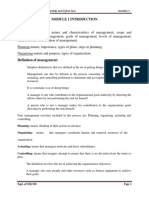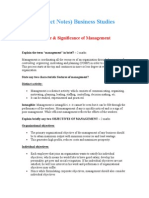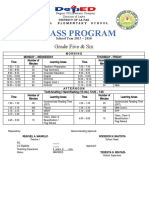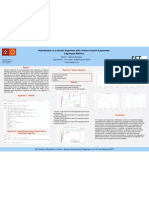Define Management & Its Functions
Define Management & Its Functions
Uploaded by
Yamson MillerJrCopyright:
Available Formats
Define Management & Its Functions
Define Management & Its Functions
Uploaded by
Yamson MillerJrOriginal Description:
Original Title
Copyright
Available Formats
Share this document
Did you find this document useful?
Is this content inappropriate?
Copyright:
Available Formats
Define Management & Its Functions
Define Management & Its Functions
Uploaded by
Yamson MillerJrCopyright:
Available Formats
DEFINE MANAGEMENT & ITS FUNCTIONS
Management is the process of reaching organizational goals by working with and through people and other
organizational resources.
Management has the following 3 characteristics:
1. It is a process or series of continuing and related activities.
2. It involves and concentrates on reaching organizational goals.
3. It reaches these goals by working with and through people and other organizational resources.
MANAGEMENT FUNCTIONS:
The 4 basic management functions that make up the management process are described in the following
sections:
1. PLANNING
2. ORGANIZING
3. INFLUENCING
4. CONTROLLING.
PLANNING: Planning involves choosing tasks that must be performed to attain organizational goals, outlining
how the tasks must be performed, and indicating when they should be performed.
Planning activity focuses on attaining goals. Managers outline exactly what organizations should do to be
successful. Planning is concerned with the success of the organization in the short term as well as in the long
term.
ORGANIZING:
Organizing can be thought of as assigning the tasks developed in the planning stages, to various individuals or
groups within the organization. Organizing is to create a mechanism to put plans into action.
People within the organization are given work assignments that contribute to the company’s goals. Tasks are
organized so that the output of each individual contributes to the success of departments, which, in turn,
contributes to the success of divisions, which ultimately contributes to the success of the organization.
INFLUENCING:
Influencing is also referred to as motivating, leading or directing. Influencing can be defined as guiding the
activities of organization members in he direction that helps the organization move towards the fulfillment of
the goals.
The purpose of influencing is to increase productivity. Human-oriented work situations usually generate higher
levels of production over the long term than do task oriented work situations because people find the latter type
distasteful.
CONTROLLING:
Controlling is the following roles played by the manager:
1. Gather information that measures performance
2. Compare present performance to pre established performance norms.
3. Determine the next action plan and modifications for meeting the desired performance parameters.
Controlling is an ongoing process.
7 Important Characteristics of Management
On the analysis of various definitions, the following characteristics of management emerge:
(1) Management is Goal-oriented Process:
No goal in the hand no need of management. In other words, we need management when we have some goals to be
achieved. A manager on the basis of his knowledge and experience tries to achieve the goals which are already decided.
Hence, nothing is wrong to say that management is a goal-oriented process.
(2) Management is All-pervasive:
Anything minus management is nothing or zero. Here by anything we mean all types of activities-business and non-
business. If we deduct management out of these activities, the result will be failure or zero. It means management is
necessary to conduct any type of activities. Hence, it is pervasive or universal.
(3) Management is Multidimensional:
The management is a three-dimensional activity:
(i) Management of Work:
Every organisation is established for doing some work, like a school provides education, a hospital treats patients, a
factory produces, etc. Of these, no work can be completed satisfactorily without management,
(ii) Management of People:
Each organisation is established for doing some work and the same is conducted by people. Hence, it is necessary to
manage the people so that the work can be accomplished in a better way.
(iii) Management of Operations:
To achieve the goals of an organisation many operations or activities need to be conducted, such as, production, sale,
purchase, finance, accounting, R&D, etc. Again, management is needed to make sure that operations are accomplished
efficiently and effectively.
(4) Management is a Continuous Process:
The various managerial activities cannot be performed once for all, but it is a continuous process. A manager is busy
sometimes in doing one managerial activity and at other times some other activity.
ADVERTISEMENTS:
(5) Management is a Group Activity:
It means that (|T-2 it is not a single person who consummates all the activities of an organisation but it is always a group
of persons (managers). Hence, management is a group effort.
(6) Management is a Dynamic Function:
Management is a dynamic activity as it has to adjust itself to the regularly changing environment. In this context, it can be
rightly said that nothing is eternal in management.
It is necessary here to clearly understand that the recognition of management in the form of group is only in reference to
big organisations, because in these kinds of organisations many managers are appointed at various managerial levels.
On the other hand, in small organisations only one manager is sufficient as he can himself manage all the affairs of the
organisation. For these kinds of organisations it would not be right to call management a group activity.
(7) Management is an Intangible Force:
Management is that power which cannot be seen. It can only be felt. If any organisation is heading toward higher levels of
achievement, it signifies the existence of good management and vice versa. In other words, achievement reflects the
quality of management and its effectiveness.
You might also like
- Chapter 1 Lesson 1Document5 pagesChapter 1 Lesson 1Zeo AlcantaraNo ratings yet
- What Is Corporate WorldDocument2 pagesWhat Is Corporate WorldAnonymous oGepdemJNo ratings yet
- Management Is The Process of Reaching Organizational Goals by Working With and Through People and Other Organizational ResourcesDocument4 pagesManagement Is The Process of Reaching Organizational Goals by Working With and Through People and Other Organizational ResourcesHtetThinzarNo ratings yet
- Management Is The Process of Reaching Organizational Goals by Working With and Through People and Other Organizational ResourcesDocument2 pagesManagement Is The Process of Reaching Organizational Goals by Working With and Through People and Other Organizational ResourcesInayat HussainNo ratings yet
- Business ManagementDocument90 pagesBusiness ManagementvishnuchandranrvNo ratings yet
- MGMT 1Document11 pagesMGMT 1getachewfikire0955955427No ratings yet
- PGDM Supply HvbgprojectDocument2 pagesPGDM Supply HvbgprojectVivek SinghNo ratings yet
- Characteristics or Features of ManagementDocument16 pagesCharacteristics or Features of Managementrinky_trivedi100% (5)
- Anglais Part I.docx FinalDocument15 pagesAnglais Part I.docx FinalCheick Ousmane KeitaNo ratings yet
- Bba 101 1-2Document38 pagesBba 101 1-2ArohiNo ratings yet
- The Complete Notes of PomDocument76 pagesThe Complete Notes of PomLors PorseenaNo ratings yet
- ME Module 1 NotesDocument56 pagesME Module 1 NotesYashashwiniNo ratings yet
- Fom NotesDocument33 pagesFom Notesshivam.nexus07No ratings yet
- Module 1 Introduction: Planning: Means Thinking of Their Actions in Advance. OrganizingDocument39 pagesModule 1 Introduction: Planning: Means Thinking of Their Actions in Advance. OrganizingMeghana MeghaNo ratings yet
- PPPPPPPPPPPPPPPPPPPPP P PP PP PP P PPPP P PP PPPPP P: PPPPPPPPPPPPPPPPPPPPPPP×PPP PPPPPPPPPPPDocument3 pagesPPPPPPPPPPPPPPPPPPPPP P PP PP PP P PPPP P PP PPPPP P: PPPPPPPPPPPPPPPPPPPPPPP×PPP PPPPPPPPPPPHusnainShahidNo ratings yet
- Nature and Significance of Management Class 12 NotesDocument30 pagesNature and Significance of Management Class 12 NotesDinesh Bothra Res-commerce AccountancyNo ratings yet
- UntitledDocument16 pagesUntitledMuluken AschaleNo ratings yet
- ManagementDocument37 pagesManagementZeshan ChNo ratings yet
- Business Studies XiiDocument93 pagesBusiness Studies XiiramanagpalNo ratings yet
- Managemt AncDocument115 pagesManagemt AncManoj JagadishNo ratings yet
- Exit Exam Course For Management DepartmentDocument9 pagesExit Exam Course For Management DepartmentLegese Tusse100% (2)
- Intro ch1Document13 pagesIntro ch1tagay mengeshaNo ratings yet
- Chapter One Management: An OverviewDocument9 pagesChapter One Management: An Overviewgetnah tenaNo ratings yet
- Importance of ManagementDocument6 pagesImportance of ManagementVenkateshNo ratings yet
- CHAPTER 1 ManagementDocument16 pagesCHAPTER 1 ManagementSemNo ratings yet
- MPOB Reference NotesDocument58 pagesMPOB Reference NotesAbcdNo ratings yet
- Concept of ManagementDocument7 pagesConcept of ManagementWamema joshuaNo ratings yet
- Chapter One ManagementDocument12 pagesChapter One ManagementmikialeNo ratings yet
- Module 1 Introduction: Planning: Means Thinking of Their Actions in Advance. OrganizingDocument34 pagesModule 1 Introduction: Planning: Means Thinking of Their Actions in Advance. OrganizingAbhishek WilsonNo ratings yet
- Me Full-1Document95 pagesMe Full-1Aishwarya LakshmanNo ratings yet
- BST Summary by Kishorsinh ChauhanDocument141 pagesBST Summary by Kishorsinh Chauhanniranjanashish07No ratings yet
- Chapter1 Introduction To Management ProcessDocument4 pagesChapter1 Introduction To Management Processsuhaib1282No ratings yet
- Nature of OrganizationDocument6 pagesNature of OrganizationShahina ParvinNo ratings yet
- Management NotesDocument2 pagesManagement Notesnishadarshad288No ratings yet
- Chapter 1 - Fundamentals of Management 1.1. Meaning and Definition of ManagementDocument16 pagesChapter 1 - Fundamentals of Management 1.1. Meaning and Definition of ManagementMuluken AschaleNo ratings yet
- What Is Management Supply Chain Management VBBDocument8 pagesWhat Is Management Supply Chain Management VBBVivek SinghNo ratings yet
- Manager and ManagingDocument3 pagesManager and ManagingAnonymous olkUZ9No ratings yet
- ECU302 LEC ON Business ManagementDocument14 pagesECU302 LEC ON Business ManagementKimani JohnNo ratings yet
- Chapter 1Document17 pagesChapter 1Shalle said AdenNo ratings yet
- PPM Notes Unit - IDocument18 pagesPPM Notes Unit - IHemanth ParakhNo ratings yet
- Assignment-Ii: What Are The Characteristics of Management?Document6 pagesAssignment-Ii: What Are The Characteristics of Management?Denis DsouzaNo ratings yet
- Chapter One RVU MT&PDocument41 pagesChapter One RVU MT&PSisay DeresaNo ratings yet
- Characteristics of MangementDocument2 pagesCharacteristics of MangementAbdur Rehman SomrooNo ratings yet
- CFLM 2 ManagementDocument5 pagesCFLM 2 ManagementgapoymackyNo ratings yet
- Unit - Iii Directing & Controlling Directing: Is Said To Be A Process in Which The Managers Instruct, Guide and Oversee TheDocument25 pagesUnit - Iii Directing & Controlling Directing: Is Said To Be A Process in Which The Managers Instruct, Guide and Oversee TheN . pavanNo ratings yet
- Introduction To ManagementDocument179 pagesIntroduction To Managementgetahunasab524No ratings yet
- MGMTDocument64 pagesMGMTሻሎም ሃፒ ታዲNo ratings yet
- Define ManagementDocument3 pagesDefine ManagementPinkish RexxNo ratings yet
- Management NotesDocument14 pagesManagement Notesnishadarshad288No ratings yet
- Subject Notes Business StudiesDocument83 pagesSubject Notes Business StudiespariteotiaNo ratings yet
- Fom - Function of Management in SamsungDocument20 pagesFom - Function of Management in SamsungPooja ShekhawatNo ratings yet
- Office Management 1aDocument22 pagesOffice Management 1aAnshu TyagiNo ratings yet
- Lecture 1-6 Pom Paf-Kiet 2021Document21 pagesLecture 1-6 Pom Paf-Kiet 2021Ahsan IqbalNo ratings yet
- Entrepreneurship and Start-Ups 03600201: Lecturer-Applied Science, Diploma StudyDocument85 pagesEntrepreneurship and Start-Ups 03600201: Lecturer-Applied Science, Diploma StudySMIT CHRISTIANNo ratings yet
- Mgmtchap 2Document103 pagesMgmtchap 2Galex BaakNo ratings yet
- HC28_Lesson 15_LContentDocument24 pagesHC28_Lesson 15_LContentmohanrajk879No ratings yet
- Management Notes 1Document9 pagesManagement Notes 1nishadarshad288No ratings yet
- Int To MGMT Chapter 1Document20 pagesInt To MGMT Chapter 1KanaalNo ratings yet
- The Staffieri Principles: A Philosophy in Employee ManagementFrom EverandThe Staffieri Principles: A Philosophy in Employee ManagementNo ratings yet
- BSP Activity-DesignDocument2 pagesBSP Activity-DesignYamson MillerJr100% (1)
- Balik Eskwela Narrative Report 2023Document4 pagesBalik Eskwela Narrative Report 2023Yamson MillerJr100% (3)
- Caraga Hymn Welcome To Our Beloved Caraga Historic Name of Region 13. God's Endless Love and Blessings Are All Bestowed Without RestraintsDocument8 pagesCaraga Hymn Welcome To Our Beloved Caraga Historic Name of Region 13. God's Endless Love and Blessings Are All Bestowed Without RestraintsYamson MillerJrNo ratings yet
- Class Program Grade 5&6Document1 pageClass Program Grade 5&6Yamson MillerJrNo ratings yet
- Caraga Hymn Welcome To Our Beloved Caraga Historic Name of Region 13. God's Endless Love and Blessings Are All Bestowed Without RestraintsDocument7 pagesCaraga Hymn Welcome To Our Beloved Caraga Historic Name of Region 13. God's Endless Love and Blessings Are All Bestowed Without RestraintsYamson MillerJrNo ratings yet
- Least Learned CompetenciesDocument10 pagesLeast Learned CompetenciesYamson MillerJrNo ratings yet
- RAMAYANADocument15 pagesRAMAYANAYamson MillerJrNo ratings yet
- The Official Publication of Burgos National High School KKGGGGJGDocument31 pagesThe Official Publication of Burgos National High School KKGGGGJGYamson MillerJrNo ratings yet
- BUILDING YOUR VOCABULARY Match The Words in Column A With Their Definitions in Column BDocument2 pagesBUILDING YOUR VOCABULARY Match The Words in Column A With Their Definitions in Column BYamson MillerJr100% (1)
- Time Sequences Spiels Audio Video Lights PropsDocument28 pagesTime Sequences Spiels Audio Video Lights PropsYamson MillerJrNo ratings yet
- Classification of PoetryDocument9 pagesClassification of PoetryYamson MillerJrNo ratings yet
- Objectives: Students Will Understand The FollowingDocument3 pagesObjectives: Students Will Understand The FollowingYamson MillerJrNo ratings yet
- Rossemblat Paper On Writing and Reading. The Transactional TheoryDocument26 pagesRossemblat Paper On Writing and Reading. The Transactional TheoryBruno JiménezNo ratings yet
- Mathematics Ims Demo PinyaDocument7 pagesMathematics Ims Demo PinyaLino CuestaNo ratings yet
- Theory Analysis Paper Tagia AlofipoDocument5 pagesTheory Analysis Paper Tagia Alofipoapi-302399342No ratings yet
- Project Proposal School IntramuralsDocument5 pagesProject Proposal School IntramuralsJho Anna DorcasNo ratings yet
- Brandi T Sweat ResumeDocument3 pagesBrandi T Sweat Resumeapi-256635702No ratings yet
- Reflective Essay F.ADocument4 pagesReflective Essay F.AAbdelghni IdrissiNo ratings yet
- Week 4 Reflection - ROUGH DRAFTDocument5 pagesWeek 4 Reflection - ROUGH DRAFTtashasmithNo ratings yet
- Human Growth and DevelopmentDocument12 pagesHuman Growth and DevelopmentEx SolNo ratings yet
- Research Design: Memcha Loitongbam Professor MIMS, Manipur UniversityDocument75 pagesResearch Design: Memcha Loitongbam Professor MIMS, Manipur UniversityWolfie BoNo ratings yet
- Psi Senses Bubble Gum ActivityDocument2 pagesPsi Senses Bubble Gum Activityapi-238109871No ratings yet
- Book Reviews: The Modern LanguageDocument12 pagesBook Reviews: The Modern LanguageVassilis PetrakisNo ratings yet
- Instant Download The Routledge International Handbook of Early Childhood Play 1st Edition Tina Bruce PDF All ChaptersDocument69 pagesInstant Download The Routledge International Handbook of Early Childhood Play 1st Edition Tina Bruce PDF All Chapterszsocikinard100% (2)
- Wright Enneagram HandbookDocument32 pagesWright Enneagram HandbookTomasz Dragonski100% (14)
- Grade-4 DLL Sy 2022-2023 Week 1Document23 pagesGrade-4 DLL Sy 2022-2023 Week 1Novianne Z SabueroNo ratings yet
- Scientific MethodDocument3 pagesScientific MethodkeidieNo ratings yet
- Melanesian Journal of TheologyDocument102 pagesMelanesian Journal of TheologyKembol KepNo ratings yet
- Media and Information Literacy MIL Media and Information Literate IndividualDocument12 pagesMedia and Information Literacy MIL Media and Information Literate IndividualRishell Joy LatNo ratings yet
- Introduction To Psychology - KarolDocument50 pagesIntroduction To Psychology - KarolAgyekum PaulNo ratings yet
- Therapeutic ModalitiesDocument71 pagesTherapeutic ModalitiesNestor Jr. Isada100% (1)
- Tg-In-Reading Intervention April 5, 2024Document3 pagesTg-In-Reading Intervention April 5, 2024catherine.sales003No ratings yet
- تطبيقات الحاسوب ٢Document9 pagesتطبيقات الحاسوب ٢Rhma mhmoud Rhma mhmoudNo ratings yet
- Prescriptive Descriptive GrammarDocument4 pagesPrescriptive Descriptive GrammarAnis Fadzilah Zulkifle0% (1)
- Conversational FillersDocument10 pagesConversational FillersYolowii XanaNo ratings yet
- Example Research Scenarios 59abab1b1723dd0a87b49f65Document5 pagesExample Research Scenarios 59abab1b1723dd0a87b49f65UsamaNo ratings yet
- Hybridization of A Genetic Algorithm With A Pattern Search Augmented Lagrangian MethodDocument1 pageHybridization of A Genetic Algorithm With A Pattern Search Augmented Lagrangian MethodSemana da Escola de Engenharia da Universidade do MinhoNo ratings yet
- Grudge BallDocument6 pagesGrudge BallMelissa MendozaNo ratings yet
- Lesson Plan Essay Structure Group Lesson and ActivityDocument3 pagesLesson Plan Essay Structure Group Lesson and ActivityMD Bazlul KarimNo ratings yet
- Memory LectureDocument7 pagesMemory LecturemadlesissacNo ratings yet
- GE 105 Activity by SusarnoDocument2 pagesGE 105 Activity by SusarnoClint Abonares SusarnoNo ratings yet





































































































